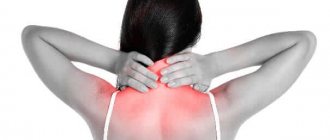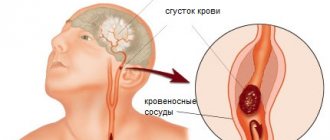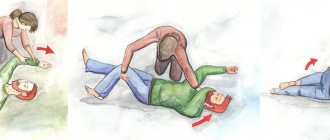Causes of pathology
The reasons for the development of neuralgia can be different: inflammatory processes, injuries, bacteria and viruses, poisoning with drugs and various substances, autoimmune diseases, circulatory disorders in the vessels supplying the nerve.
- infections such as shingles, Lyme disease, or HIV
- pressure on bone nerves, blood vessels or tumors
- kidney disease or diabetes
- age
our treatment
Unlike standard treatment, aimed at reducing the sensitivity of the nervous system to provoking factors, our approach involves eliminating the cause of the malfunction of the nervous system, leading to cardioneurosis.
We restore impaired cerebral blood flow as the main cause of disruption of the nervous system and the development of cardioneurosis.
To restore cerebral blood flow, we use our own patented technology (Patent No. 2571234). In addition, osteopathic sessions are used to correct the skull, cervical spine and chest, as well as reflexology.
After the course of treatment, normal functioning of the nervous system is restored and manifestations of cardioneurosis disappear.
What are the symptoms of intercostal neuralgia?
- Sudden episodes of severe shooting or stabbing pain that follows the path of a damaged or irritated nerve. Symptoms appear on either the right or left side. The pain intensifies with any movement.
- Constant aching or burning pain.
- Tingling or numbness.
- Muscle weakness.
- Loss of muscle mass or atrophy.
- Involuntary muscle twitching or spasms.
In children, characteristic pain occurs during a period of intense growth, when the skeleton is growing rapidly. Severe pain in the affected areas and cramps are the main symptoms of neuralgia by which the disease is recognized in children. Additional signs include profuse sweating, increased excitability, tearfulness, sleep disturbance and stuttering.
The main goal of treatment is to distinguish this disease from others. It is important to distinguish attacks of neuralgia from manifestations of heart attack and angina. With neuralgia, there is no fever, shortness of breath, difficulty breathing, or blue discoloration of the skin.
Differentiation of neuralgia and heart pain
It is important to know the difference between heart pain and neuralgia in order to provide or receive timely help.
Important differences in the manifestation of pathologies:
- pain syndrome. With neuralgia, any body movements, including inhalation and exhalation and normal walking, lead to increased pain. When there is pain in the heart, its intensity does not change depending on the depth of breathing;
- duration of the attack. Heart pain can be relieved in 15-20 minutes by taking medicine (validol, nitroglycerin). These drugs will not help with neuralgia;
- arterial pressure. Cardiovascular disorders lead to increased blood pressure during a painful attack and increased heart rate. Neuralgia does not cause changes in blood pressure;
- nature of pain. Coronarogenic pain in the heart is strong, pressing, with neuralgia it is burning and short-lived;
- localization. In case of heart problems, the pain is concentrated on the left or behind the sternum, neuralgia is accompanied by pain along the affected nerve;
- additional symptoms. Coronarogenic pain syndrome can be accompanied by cold sweat, pallor, and a feeling of shortness of breath. If the pain is of neurological origin, sweating, increased blood pressure, and limited mobility are possible;
- provoking factors. Heart pain can be associated with physical and emotional stress. Neuralgia is caused by sudden movements and uncomfortable posture;
- reaction to medications. Pain in the heart is relieved by treatment with nitroglycerin; neuralgia can be relieved by taking NSAIDs.
These signs are key in recognizing the nature of pain. But for an accurate diagnosis, additional examination is required. To identify the nature of the pathology, specialists from the IntegraMed CDC (formerly NDC) in St. Petersburg prescribe the following procedures:
- appointment with a cardiologist;
- appointment with a therapist;
- CT scan;
- Ultrasound;
- ECHO-cardiography;
- MRI of the spinal column.
Diagnostic methods
You need to see a general practitioner. After examination and exclusion of other pathologies, the therapist refers to a neurologist who determines the symptoms and treats intercostal neuralgia. The doctor examines the images, prescribes tests and medical examinations.
Instrumental diagnostic methods of examination:
- Radiography. Allows you to examine the bone structure. Makes it possible to determine the presence of non-traumatic or traumatic disorders. X-rays are taken in direct, oblique and lateral projections.
- CT scan. Examines bone and muscle structure in combination. More often used to detect pathological changes in bone structures.
- Myelography. A contrast agent is injected into the spinal canal. This is the main method for diagnosing soft tissue structures (nerve roots and spinal cord).
- Contrasting discography. During the procedure, a contrast agent is injected into the intervertebral disc.
- Magnetic resonance imaging. Allows you to obtain images of organs and tissues. Detects pathological changes in soft tissue structures: nerve tissue, muscles, ligaments, hernias and degenerative changes in intervertebral hernias.
- Electrospondylography. Using the computer diagnostic method, it is possible to assess the condition of the spinal column, identify the disease at an early stage, determine the extent of damage and monitor the course of the disease.
Diagnostics
A tightness in the chest on the left is often disguised as heart disease. Some people mistake the acute pain for an angina attack or even a heart attack, given the intensity of the pain. A doctor can distinguish these diseases by conducting an examination, including an ECG, echocardiography, and blood tests. It is characteristic that the pain that occurs when a nerve is pinched in the thoracic spine on the left is not relieved by cardiac medications (validol, nitroglycerin).
Often the pain radiates to the epigastric region, hypochondrium, and lower back. Then diseases of the stomach, intestines, liver, and kidneys should be excluded.
The osteopath conducts a detailed survey of the patient and palpates points along the spine. When a nerve is pinched in the thoracic spine, it is these zones (1.5 cm to the side of the spinal column) that are characterized by maximum pain. Because this is where the nerve exits under the skin.
X-ray methods help to identify abnormalities in the structure of the spine. The most accurate additional study for pathology of soft tissues is MRI, bones - CT. A consultation with a neurologist is required. He diagnoses at what level the nerve is pinched in the thoracic region and prescribes treatment.
Methods for treating intercostal neuralgia
Drug therapy. There is a wide variety of drugs to eliminate pinched nerves: painkillers, anti-inflammatory drugs, those that increase the body’s defenses, injections, blockades. All drugs have a long list of side effects, so before using them you need to consult a specialist. Any medicine is selected depending on the severity, tendency to allergies, and the characteristics of the course of the disease.
- Anticonvulsants inhibit the conduction of pain impulses.
- Tricyclic antidepressants relieve tension in chronic pain syndromes.
- Venotonics and diuretics relieve swelling.
- Corticosteroid drugs are used in cases of severe inflammation.
- Vitamins B1, B6 and B1 accelerate the restoration of the nerve sheath, reduce inflammation and pain.
Compresses. They can be either hot or cold. They are used to reduce inflammation and also to reduce pain. This is only a temporary measure and has no therapeutic effect.
Other methods: gymnastics, shock wave therapy, massage, physiotherapy - alleviate your condition, ensuring complete recovery. And these procedures do not harm the body.
Physiotherapy and exercise therapy. Intercostal neuralgia is often caused by poor posture. The goal of physical therapy is to relieve the back muscles and open the chest. Therapeutic exercises should be performed 3-4 times a day.
Physiotherapy includes acupuncture, osteopathy, manual therapy, massage with warming creams and ointments, and kinesiotaping. They relax the fascia of the chest and back. Heat helps to temporarily relax muscles, relieve swelling, inflammation and acute pain.
Massotherapy. It should be done while sitting. When performing the procedure, the intercostal spaces are rubbed and stroked with your fingertips. In addition to this, they knead and rub the back muscles with both hands. During acupressure massage, use your fingers to press on active points associated with one or another affected organ. Acupressure can stimulate defenses and relieve pain.
Principles of treatment
Pain relief is aimed at reducing pain and eliminating muscle spasms in the affected area. If taking NSAIDs orally or by injection does not help, blockades are performed. This is the introduction of drugs into the most painful points, which are projections of the exit of nerves. Local anesthetics, hormones, NSAIDs, and muscle relaxants are used. Diuretics reduce swelling of the compressed nerve and eliminate pain. Drugs are prescribed that improve the conductivity of nerve tissue.
In addition to relieving acute pain, it is necessary to influence the cause of pinching of the intercostal nerve in the thoracic region. Medicines, massages, manual therapy, physiotherapeutic procedures, reflexology, and physical therapy help reduce the destruction of bones and joints. Medicines prescribed:
- vascular drugs - improve blood circulation;
- chondroprotectors – restore the properties of the cartilage layer between the vertebrae;
- calcium supplements, vitamin D fight osteoporosis;
- multivitamin complexes with minerals.
Acupressure, lymphatic drainage and classic types of massage are used. The impact on the back muscles helps eliminate spasms, improves blood flow and tissue nutrition. Thanks to this, it is possible to break the pathological circle, when pain causes muscle contraction, which compresses nerve fibers and blood vessels, disrupting blood supply and increasing pain.
In some cases, surgical treatments may even be necessary. For example, to eliminate the consequences of an injury, remove a significant hernia, tumor, or perform spinal stabilization.
Every person should be attentive to their health and not ignore the symptoms of a pinched nerve in the thoracic region if they appear. It is important to seek qualified help immediately. After all, the earlier the problem is identified, the greater the chances of achieving complete restoration of the function of the nerves and all structures of the spinal column, and of avoiding another pinching under the breast in the future.
Treatment of intercostal neuralgia during pregnancy
During pregnancy, the presence of neuralgia is considered a fairly serious problem. It requires proper attention, which will help avoid complications for the expectant mother and baby.
All treatment that will be given to a pregnant woman for neuralgia must be prescribed by the attending physician. Self-therapy is extremely undesirable, as it can greatly harm the woman and the child in the womb.
Many patients prefer not to take medications. They limit themselves to vitamins and mineral complexes, use ointments and warm compresses, observe bed rest and perform simple physical exercises.
Gymnastics for neuralgic pain in pregnant women is very effective. Physical exercise does not allow blood to stagnate in the joints and parts of the spine.
If the pain becomes unbearable, novocaine blockades are prescribed with caution.
First aid and self-help for a heart attack
A heart attack is a serious pathological condition caused by an acute lack of blood supply to the heart muscle with the subsequent development of death of a section of this muscle. Necrosis
heart muscle is called myocardial infarction.
The most common symptoms of a heart attack are:
- Localization: in the chest area (behind the sternum), pain can radiate to the left arm to the forearm, hand, left shoulder blade, left half of the neck and lower jaw, as well as to both shoulders, both arms, upper abdomen
- Nature of pain: pressing, squeezing, burning or aching intense pain
- Stitching, cutting, aching pains that intensify with changes in body position or when breathing are not characteristic of a true heart attack
- Pain is usually accompanied by shortness of breath, weakness, severe sweating
- Duration of pain more than 5 minutes
What should you do if you have a heart attack?
- Sit (preferably in a chair with armrests) or lie in bed with the head of the bed raised
- Free your neck and provide fresh air (open the vents or window)
- Take 0.25 g of aspirin (chew the tablet, swallow) and 0.5 mg of nitroglycerin (put the tablet/capsule under the tongue, first bite the capsule, do not swallow)
- If, after taking nitroglycerin, severe weakness, sweating, shortness of breath, or a sharp headache appears, then you need to lie down, raise your legs (on a bolster, pillow, etc.), drink 1 glass of water and then you should not take any more nitroglycerin
- If after taking aspirin and nitroglycerin the pain has completely disappeared and the condition has improved, you need to call a doctor at home
- If the pain persists, it is necessary to take nitroglycerin a second time and urgently call an ambulance
- If pain persists 10 minutes after taking the second dose of nitroglycerin, it is necessary to take nitroglycerin for the third time.
ATTENTION! If nitroglycerin or aspirin is not available and the pain persists for more than 5 minutes, call an ambulance immediately.
- A patient with a heart attack is strictly prohibited from standing, walking, smoking or eating until specifically authorized by a doctor.
- Aspirin (acetylsalicylic acid) is contraindicated if you are intolerant to the drug (allergic reactions in the past), or if you have already taken it that day, as well as with a clear exacerbation of gastric and duodenal ulcers
- You should not take nitroglycerin if you have low blood pressure, severe weakness, sweating, as well as severe headache, dizziness, acute impairment of vision, speech or coordination of movements.
- If you have been diagnosed with coronary heart disease or, according to your doctor, you have an increased risk of developing a heart attack, you need to be well aware of the rules of first aid for a heart attack and always have aspirin and nitroglycerin in your pocket
How to give first aid to yourself?
There are different situations in life. What to do if a person cannot seek help, finding himself alone with a heart attack, when it is impossible to reach the phone to call an ambulance, and there is no medicine nearby?
In the event of a heart attack, you cannot waste precious time and you must start... coughing! And as strong as possible!
Before coughing, be sure to take a deep breath. The cough should be deep, “chest”.
The frequency of “inhale-cough” is approximately every 2 seconds. You should do this until you feel a little better so that you can take medicine, if you have one, and call a doctor.
The mechanism of action here is very simple. Taking deep breaths brings oxygen to the lungs, and coughing compresses the heart muscle and causes blood to circulate better. This helps the heart restore its normal rhythm.
What else is important to know?
- Keep your heart medications with you, even if you don't consider yourself a heart patient. By the way, a person with heart failure who constantly carries nitroglycerin or valocordin with him is in a better position than someone who considers himself healthy and does not take medications with him
- Learn the rule: heart medications should always be on hand! Keep them in your desk drawer, your nightstand drawer, and your clothing pockets. If you don’t need them personally, they may be useful to someone else who feels ill with their heart in your presence.
- You should always have a phone at hand - landline or mobile. Of course, it’s not a fact that in case of a sudden deterioration in your health you will be able to use it, but still it is at least some kind of safety net
- If you are experiencing severe stress, try to breathe deeply (even if there are no signs of a heart attack)
- If possible, avoid driving
- Take anti-anxiety medications as prescribed by your doctor
Take care of your health!
Valeologist of the prevention department of the healthcare institution “40th GKP” M. Vereshchagina
Prevention of intercostal neuralgia
The main preventive measure is gymnastics. It is necessary to perform exercises that promote muscle development, strengthening and mobility of the spine. Avoid drafts, uncomfortable positions and excessive physical activity. Everything should be in moderation.
It is important to control your posture, not lift excessive weights, eat a rational and balanced diet, take vitamins, and avoid fasting and mono-diet.
Do not forget to promptly treat diseases that can cause the development of neuralgia.










